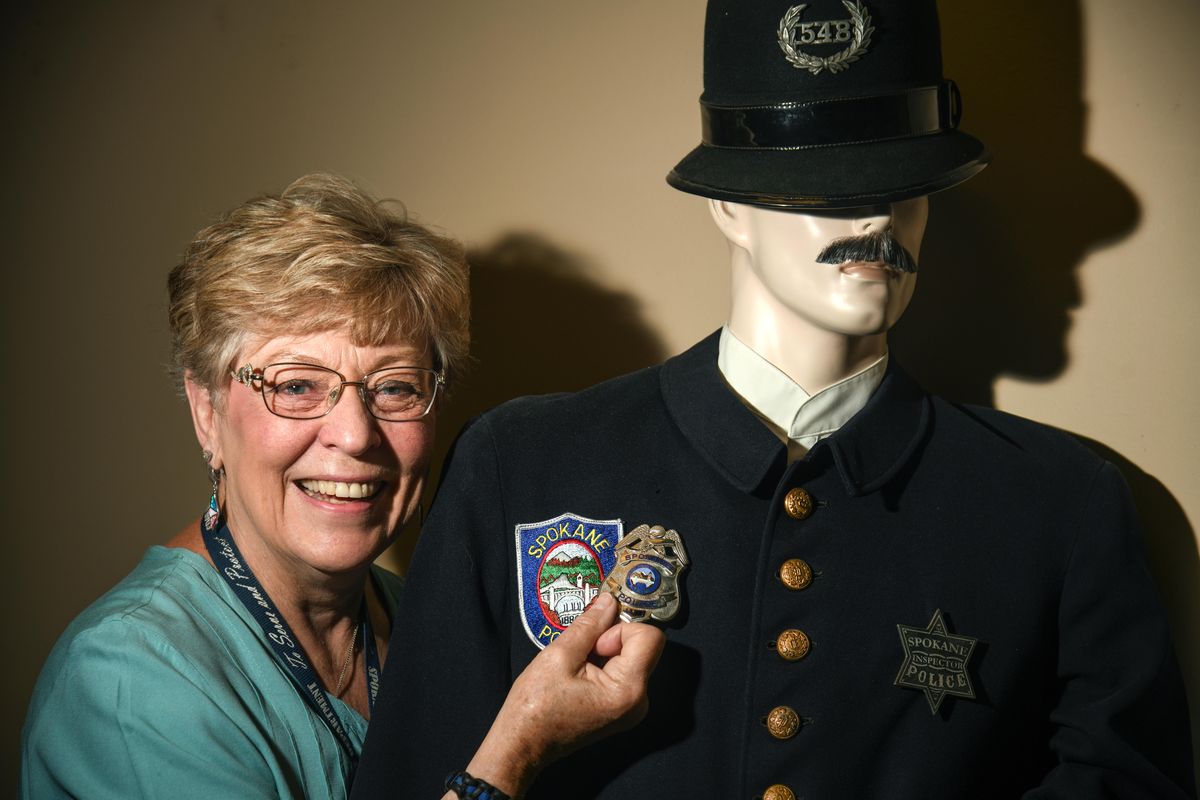Historians persuade Spokane police to correct error on their uniforms – date of department’s founding
Both the current Spokane Police patch and badge have the 1884 year displayed on the front. New ones will have the corrected 1881. (Dan Pelle / The Spokesman-Review)Buy a print of this photo
On Feb. 23, 1883, Spokane’s city marshal, Eugene Hyde, led a handcuffed man twice his size, drunk with a belly full of gin, to the log building at 220 N. Post St. that served as the city jail.
Hyde, with slicked-back hair and a large mustache that covered his upper lip, carried a .44 revolver and was known to be quick with a gun. On that day, according to an article in the Spokane Falls Review, the man he arrested that day was being obedient.
That changed once Hyde slid his key into the jail cell lock. The man “grabbed the lapel of the overcoat and squared himself for a fracas.”
Hyde cocked his fist back and punched the man. Hyde dislocated his finger, and the man fell but held onto Hyde’s overcoat and ripped it in half. Hyde dragged him into the cell.
By that time, Hyde was a seasoned law enforcer in the earliest years of Spokane. He was nearing his third year as the city marshal, appointed by the mayor. Although his title didn’t reflect it at the time, Hyde was the city’s first policeman. In 1881, he was the first and sole member of the city’s police force.
It’s been 138 years since Hyde first put on his badge. But the city police force that grew from Hyde doesn’t reflect that.

Just look at any current officer’s patches and badges.
They show three peaks: the U.S. Pavilion and the Clocktower – both in Riverfront Park – and Mount Spokane. Underneath them, the Spokane Falls tumble under the Monroe Street Bridge. The landmarks aren’t laid out with geographic accuracy, but another inaccuracy is stitched in yellow: The founding date is labeled 1884 – three years after Hyde was first tasked with policing the city.
For 16 years, a group of historians has lobbied police chiefs and mayors to correct the department’s patches and badges that have shown the wrong founding date. But now, new patches with the correct date are on order, and Hyde’s early contribution to Spokane’s law enforcement history will be recognized.
Finding the error
Sue Walker oversees part of what’s left of the the Spokane Regional Law Enforcement Museum, housed in the unassuming Public Safety Building that stands between the castle-like, white brick tower of the Spokane County Courthouse and the sleek black-glass county jail.
Apart from keeping track of the rusting revolvers and fading uniforms, and acting as the museum’s secretary and treasurer, Walker has been writing letters and pleading with police chiefs and mayors for 16 years to correct the date error on the badges and patches.
In 2003, she was hired to create a history book about the police department and became the chairman of a group of historians called the Spokane Police Department History Committee.
Not long after the group first sat down to meet, Tony Bamonte, a member who was a former policeman and sheriff in Pend Oreille County, pointed out the 1884 error, Walker said.
So the group began to dig, guided by Bamonte, who has a history of uncovering corruption in law enforcement and who wrote a local history book. Bamonte died earlier this month.
They wanted to find out how the decision was made. They called former police chiefs, mayors and police staff.
They narrowed it down to one document.
On Walker’s desk is a copy of a 1984 proclamation from Mayor James Chase that states the library, the police department and the fire department were all founded in 1884.
“This is erroneous,” Walker said as she tapped her finger on the document.
Celebrating 1884
Walker and the History Book Committee’s research revealed that in 1984, the Spokane Fire Department and the library were set to hit 100th anniversaries, so Chase assembled a group to celebrate it.
But the group had also pinned the founding date on the 1884 hiring of a policeman named Joel Warren, likely sourced from the 1912 book “Spokane and the Inland Empire” from 1912, written by N.W. Durham, Walker said.
Under a chapter titled “Origin and development of police force,” Eugene Hyde’s name is the first bit of text, followed by his title of city marshal and “the only paid officer.”
But the book also includes Warren’s narrative of the department’s beginning, in which he implies that he is the first officially titled police officer.
“I think they might have just sort of conflated the two,” said Suzanne Bamonte, Tony’s wife and member of the History Book Committee.
To find the truth, the committee sifted through old newspaper articles and city documents from the late 1800s.
Eventually, they found that in 1881, when the Washington Legislature passed the Act to Incorporate the City of Spokane Falls and the governor signed it, the bill specified that the mayor must establish and regulate a police department.
It’s not exactly clear, but sometime after the 100-year anniversary in 1984, the police department ordered the badges stitched with 1884.
‘It’s more important to some people than others’
The main argument pursued by Bamonte, Walker and the committee was that it didn’t matter whether Hyde was called the marshal. He was operating as the first police officer because of the bill’s language.
“It doesn’t matter what their title is,” Walker said. “It matters if they are the head of that city police department. Eventually, it evolved into being the chief of police.”
Walker began inquiring about the founding date, but was rebuffed. No one would acknowledge that 1884 was an error.
Walker and the committee were undaunted. Near the entrance to the Spokane Police Department, a glass case displays “Life Behind the Badge: The Spokane Police Department’s Founding Years,” a book Walker and the History Book Committee published in 2008.
A blunt passage in the book addresses the error: “At some point in the Spokane Police Department’s more recent history, a decision was made within the department to recognize 1884 as its founding date. Unfortunately, the decision was based on erroneous information, which is not supported or upheld in any legal or official documents.”
The arguments made by Walker, Bamonte and the History Book Committee prompted former Spokane Police Department deputy chief Jim Nicks to write a department newsletter to address the issue in 2003.
“Arguments can be made for 1881, 1884, 1885 or as late as 1980 – it all depends on which of the documents you choose for your argument,” Nicks wrote. “An administrative decision was made to stay with 1884, as that has been our tradition and understanding of when the department began to move towards a multi-member ‘police force.’”
In defense of the police department’s 1884 badges, Nicks told The Spokesman-Review in 2003 that “I think it’s more important to some people than others.”
Walker and the History Book Committee reached out to everyone in Chase’s group and asked how they came up with that date, but no one could remember, she said.
Convincing the chief
Shortly after Spokane Police Department Chief Craig Miedl was hired in 2016, Walker saw an opportunity to fix the patch and badge error.
“She approached me and said she’s approached every other chief,” Meidl recalls. “None had disagreed with her, but for whatever reason, they didn’t want to move forward.”
Walker gave him a green binder with her evidence and Meidl looked it over.
“It’s an interesting piece of our history,” he wrote in a message to The Spokesman-Review. He said it was a time when Spokane was transitioning from the “wild west” to the beginning stages of a more modern era.
Meidl gave the binder to his command staff, he said. Then he consulted a history professor at Gonzaga University about the founding date.
“After reviewing it, and after getting thumbs up from the professor, I said, ‘Yes, I’m willing to move forward with it.’ ”

Meidl told Walker that he wouldn’t spend money to buy new patches and badges for the whole department, but he would order corrected ones as old ones need to be replaced.
“It’s not going to be a cost increaser,” Meidl said.
He said the issue with the patches doesn’t change the mission of the department, but it was “extremely important” to Walker and her group.
Michelle Loucks, assistant procurement specialist at the police department, said the first order of 100 patches will arrive in late August.
“I’ve got my fingers crossed that we will get them sooner,” she wrote in an email.
For the badges, getting corrected ones will depend on the department’s hiring.
“We order our new officers their badge with their number on them after they complete their probation; until that time they have a temporary badge that doesn’t have a number on it, that way we can use them over and over,” she wrote in the email.
Honoring Bamonte
As Bamonte’s health deteriorated in the past year, the police department rushed to order the new patches so they could ceremonially give one to Bamonte and credit him for his work, Walker said.
Bamonte was instrumental in documenting the facts about the department’s founding, Walker said. He was a key member of the committee and helped write the first book, after which he advised the committee on their practices.
“He felt (the date) should be changed,” Walker said. “I just wanted him to have that.”
Walker remembers giving Bamonte the news that Meidl had decided to order the new patches.
“He was thrilled,” Walker said.
She kept him updated on the project as his pancreatic cancer advanced, but the police department’s lengthy process in buying new gear, which involves taking bids from sellers, delayed getting the new patches. .
Three days before he died, Walker visited Bamonte in hospice care. He had fallen and hit his head, which left him with some brain damage, Suzanne Bamonte said.
Bamonte was only sometimes responsive, but Walker told him the patches were finally ordered and that she wanted to get him one.
“He got a big smile on his face,” Walker said. “That meant an awful lot. He figured it was a lost cause and it would never happen.”
Bamonte died in the early hours of July 11, before Walker could get him a new patch.
“I never gave up,” Walker said.

